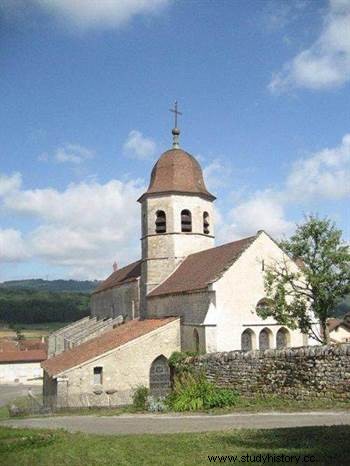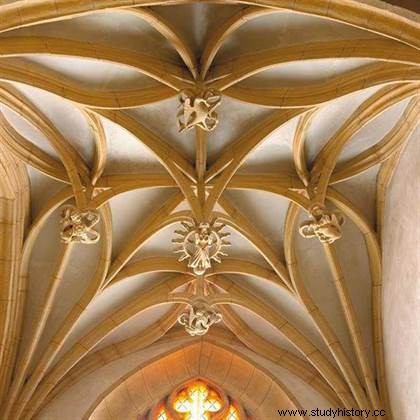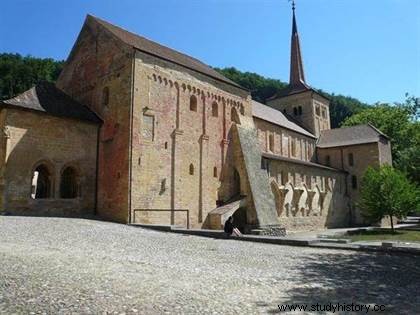 Like ducal Burgundy, a true land of Western medieval monasticism, Transjuran Burgundy also presents itself as a land of predilection where many monastic foundations developed from the time of the Burgundian kingdom. It is also in these lands that we must look for the historical sources of Cluny "beacon of the medieval West" with its first abbot Bernon taking us to the beginning of the 10th
th
century a small group of monks from two abbeys in the Jura. The celebrations of the 1100th anniversary of the founding of Cluny give us the opportunity to go back to basics with a non-exhaustive overview of the rich and important Clunisian heritage of the Jura .
Like ducal Burgundy, a true land of Western medieval monasticism, Transjuran Burgundy also presents itself as a land of predilection where many monastic foundations developed from the time of the Burgundian kingdom. It is also in these lands that we must look for the historical sources of Cluny "beacon of the medieval West" with its first abbot Bernon taking us to the beginning of the 10th
th
century a small group of monks from two abbeys in the Jura. The celebrations of the 1100th anniversary of the founding of Cluny give us the opportunity to go back to basics with a non-exhaustive overview of the rich and important Clunisian heritage of the Jura .
Baume-les-Messieurs Abbey
Of the Cluniac abbeys in the Jura, the best known is certainly that of Baume-les-Messieurs. Ranked among the "most beautiful villages in France", the site owes its charm above all to its topographical location. Located in a remote, real and picturesque end of the world, we can easily understand the choice of such a place for a monastic building which was with Gigny, the "mother" of Cluny. Indeed, from this abbey six monks left in 909 with six others from Gigny under the direction of Bernon to found Cluny thus giving birth to an order which played a preponderant role in the monastic renewal of the 10th th and XI th century of the medieval West. It is thus from this place that the powerful Cluniac order was born, which at the beginning of the twelfth th century – its peak – had more than 1100 monasteries across Europe.
 However, Baume's interest does not lie simply in her title of "mother" of Cluny, nor does is limited to its magnificent natural site but also goes through its architecture ranging from Romanesque art to a Flemish altarpiece from the 16th
th
century, recently restored and definitely not to be missed. Secularized in 1759, then sold as national property, the abbey now belongs to around fifteen owners, including the General Council of the Jura, which organizes exhibitions in the abbey dwelling combining art and history to offer an appreciable new and crossed look at the site. and its history.
However, Baume's interest does not lie simply in her title of "mother" of Cluny, nor does is limited to its magnificent natural site but also goes through its architecture ranging from Romanesque art to a Flemish altarpiece from the 16th
th
century, recently restored and definitely not to be missed. Secularized in 1759, then sold as national property, the abbey now belongs to around fifteen owners, including the General Council of the Jura, which organizes exhibitions in the abbey dwelling combining art and history to offer an appreciable new and crossed look at the site. and its history.
The abbey church of Gigny-sur-Suran
 Often eclipsed by Baume "the majestic", the discreet and modest abbey of Gigny of which only remains today that the abbey church is the true origin of Cluny. It was on this site that in 890, Abbot Bernon decided to implement a reform of Benedictine life while escaping from temporal power, placing the abbey under the protection of the apostles Saint Peter and Saint Paul. The monks of Gigny are accountable only to their successor on the Holy See, namely the Pope. The experience will then be successfully repeated in Baume-les-Messieurs and especially in Cluny.
Often eclipsed by Baume "the majestic", the discreet and modest abbey of Gigny of which only remains today that the abbey church is the true origin of Cluny. It was on this site that in 890, Abbot Bernon decided to implement a reform of Benedictine life while escaping from temporal power, placing the abbey under the protection of the apostles Saint Peter and Saint Paul. The monks of Gigny are accountable only to their successor on the Holy See, namely the Pope. The experience will then be successfully repeated in Baume-les-Messieurs and especially in Cluny.
Somewhat isolated from tourist routes, the site is not to be overlooked. On the contrary, steeped in the history of the Cluniac order, the church is a valuable testimony to early Romanesque art, such as the octagonal pillars of the nave. While some modifications have naturally taken place over the centuries, the monument remains a very fine and interesting example of early 11th century architecture. century, explained by panels inside the church.
Mièges and Nozeroy
If the Cluniac churches of the neighboring villages of Mièges and Nozeroy have a priori no interest in their external appearance – loss of their bell towers following fires –, it would be a challenge than to miss the visit of their interiors having benefited from the artistic influence of the court of the Dukes of Burgundy of the XIV and XV e centuries.
The church of Saint Germain de Mièges,  naked at the end of the XI
e
century a priory dependent on Cluny, appears of a relatively impressive size for its very modest village, especially as it is covered with ornaments mainly from the flamboyant Gothic style with in particular many vine leaves or even outside the building of sirens but also of early Renaissance style column bases. The real gem is the small so-called Chalon chapel located to the right of the choir with these hanging keystones representing Christ in the center, surrounded by the four Evangelists.
naked at the end of the XI
e
century a priory dependent on Cluny, appears of a relatively impressive size for its very modest village, especially as it is covered with ornaments mainly from the flamboyant Gothic style with in particular many vine leaves or even outside the building of sirens but also of early Renaissance style column bases. The real gem is the small so-called Chalon chapel located to the right of the choir with these hanging keystones representing Christ in the center, surrounded by the four Evangelists.
However, this small priory left the Cluniac order at the end of the Middle Ages, torn away by the collegiate church of the neighboring town of Nozeroy, today classified among the "most beautiful villages in France", once a fortress and seat of the powerful lords of Chalon. The latter built at the beginning of the XV e , on the site of a 13 th chapel , former dependency of the priory of Mièges, the collegiate church of Saint Antoine whose interior presents interesting elements of flamboyant Gothic. But the main interest of this church lies above all in three straw embroideries of the XVII th century, located on antependia (in front of the altar). To replace gold, the nuns embroidered with "orfrey", wheat straw on silk, thus constituting a work quite unique in Europe and certainly a curiosity worth the detour.
Romainmôtier, the oldest Romanesque church in Switzerland
 In the Swiss Jura – region of Yverdon les Bains – is certainly the oldest monastery in the country, founded around 450. In the VII
th
century, it is placed under the rule of Saint Colomban, it is then a modest construction which passes to the IX
e
century under the ownership of the ephemeral kingdom of Bourgogne transjurane. Around 928-929, the monastery was given to the order of Cluny. Begins a boom phase resulting in particular in an architectural development until the 16
th
century and the Reformation. The abbey suffered then the iconoclasm of the Bernese and saw the destruction of its cloister of which the foundations remain.
In the Swiss Jura – region of Yverdon les Bains – is certainly the oldest monastery in the country, founded around 450. In the VII
th
century, it is placed under the rule of Saint Colomban, it is then a modest construction which passes to the IX
e
century under the ownership of the ephemeral kingdom of Bourgogne transjurane. Around 928-929, the monastery was given to the order of Cluny. Begins a boom phase resulting in particular in an architectural development until the 16
th
century and the Reformation. The abbey suffered then the iconoclasm of the Bernese and saw the destruction of its cloister of which the foundations remain.
The abbey nevertheless remains a formidable site above all for its Romanesque church, built according to a plan identical to the (destroyed) church of Cluny when a fire during the period medieval allowed the transition from Romanesque to Gothic art giving rise to magnificent colored vaults, murals or the strange pink and green wall decoration of the choir resembling "thumbprints".
The tithe barn, 18th century building century now serves as a museum and hosts an exhibition in the wake of the 1100 years of Cluny. This exhibition presents two main subjects:the first addresses iconoclasm through fragments of statues representative of Cluniac art having suffered the effects of the Reformation (destruction of faces or heads); the second theme focuses on the funerary monuments of the grand priors of Romainmôtier. A very interesting computer-generated image film retraces the history of the site from the V th century, explaining the different stages of the construction of this high place of Cluniac heritage.
The Cluniac heritage of the Jura
 The various Cluniac sites have marked the architecture and life of the Jura. Through churches of the rare first Romanesque style like Gigny or Baume-les-Messieurs, Gothic churches representative of the artistic development of the court of the Dukes of Burgundy like Mièges or even abbey churches mixing Romanesque and Gothic like Romainmôtier, the Jura both French and Switzerland retains an important and considerable heritage of which we have only given a brief overview.
The various Cluniac sites have marked the architecture and life of the Jura. Through churches of the rare first Romanesque style like Gigny or Baume-les-Messieurs, Gothic churches representative of the artistic development of the court of the Dukes of Burgundy like Mièges or even abbey churches mixing Romanesque and Gothic like Romainmôtier, the Jura both French and Switzerland retains an important and considerable heritage of which we have only given a brief overview.
Other sites such as the funeral chapel and the large cloister of the Abbey of Saint Claude, the priory of Saint Christophe in Ruffey sur Seille (private but can be visited during heritage days or by appointment), the church of Mouthier-Vieillard in Poligny, the priory of Vaux sur Poligny or the college of Saint Jérôme in Dole are all other buildings of art and history.
